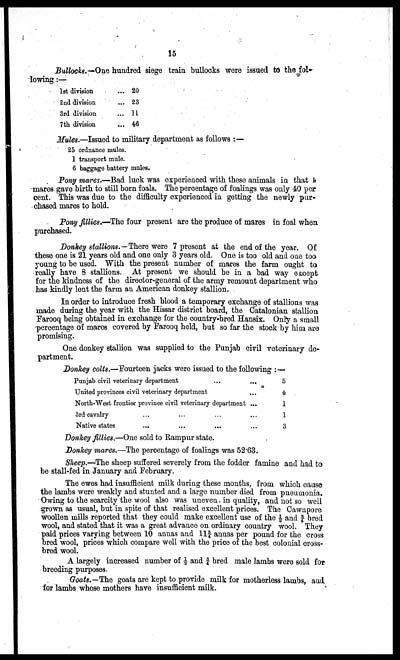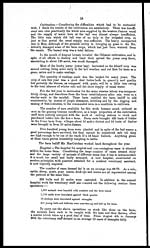Medicine - Veterinary > Civil Veterinary Departments > 1894-1932 - Annual report of the Punjab Veterinary College and of the Civil Veterinary Department, Punjab > 1909-1919 > 1913-1914 - Annual report on the Punjab Veterinary College, Civil Veterinary Department, Punjab, and the Government cattle farm, Hissar, for the year 1913-14
(233) Page 15
Download files
Individual page:
Thumbnail gallery: Grid view | List view

15
Buttocks.—One hundred siege train bullocks were issued to the fol-
lowing:—
|
1st division |
... 20 |
|
2nd division |
... 23 |
|
3rd division |
... 11 |
|
7th division |
... 46 |
Mules.—Issued to military department as follows:—
25 ordnance mules.
1 transport mule.
6 baggage battery mules.
Pony mares.—Bad luck was experienced with these animals in that
mares gave birth to still born foals. The percentage of foalings was only 40 per
cent. This was due to the difficulty experienced in getting the newly pur-
chased mares to hold.
Pony fillies.—The four present are the produce of mares in foal when
purchased.
Donkey stallions.—There were 7 present at the end of the year. Of
these one is 21 years old and one only 3 years old. One is too old and one too
young to be used. With the present number of mares the farm ought to
really have 8 stallions. At present we should be in a bad way except
for the kindness of the director-general of the army remount department who
has kindly lent the farm an American donkey stallion.
In order to introduce fresh blood a temporary exchange of stallions was
made during the year with the Hissar district board, the Catalonian stallion
Farooq being obtained in exchange for the country-bred Hansix. Only a small
percentage of mares covered by Farooq held, but so far the stock by him are
promising.
One donkey stallion was supplied to the Punjab civil veterinary de-
partment.
Donkey colts.—Fourteen jacks were issued to the following:—
|
Punjab civil veterinary department |
... |
... |
5 |
||
|
United provinces civil veterinary department |
... |
4, |
|||
|
North-West frontier province civil veterinary department |
... |
1 |
|||
|
3rd cavalry |
... |
... |
... |
1 |
|
|
Native states |
... |
... |
... |
3 |
|
Donkey fillies.—One sold to Rampur state.
Donkey mares.—The percentage of foalings was 52.63.
Sheep.—The sheep suffered severely from the fodder famine and had to
be stall-fed in January and February.
The ewes had insufficient milk during these months, from which cause
the lambs were weakly and stunted and a large number died from pneumonia.
Owing to the scarcity the wool also was uneven in quality, and not so well
grown as usual, but in spite of that realised excellent prices. The Cawnpore
woollen mills reported that they could make excellent use of the ½ and 3/4 bred
wool, and stated that it was a great advance on ordinary country wool. They
paid prices varying between 10 annas and 11¾ annas per pound for the cross
bred wool, prices which compare well with the price of the best colonial cross-
bred wool.
A largely increased number of ½ and 3/4 bred male lambs were sold for
breeding purposes.
Goats.—The goats are kept to provide milk for motherless lambs, and
for lambs whose mothers have insufficient milk.
Set display mode to: Large image | Zoom image | Transcription
Images and transcriptions on this page, including medium image downloads, may be used under the Creative Commons Attribution 4.0 International Licence unless otherwise stated. ![]()
| Permanent URL | https://digital.nls.uk/75531789 |
|---|
| Additional NLS resources: |
|---|




